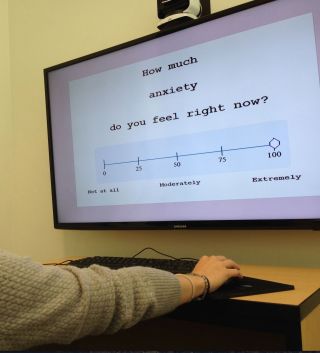In cognitive behavioral therapy (CBT), we help our patients face their fears by teaching them a technique known as exposure. In a nutshell, exposure consists of gradually coming into contact with those objects and situations that elicit fear in order to allow ourselves to feel that fear. For example, a patient doing exposure for social anxiety might go to a party and introduce himself to a stranger. Or a woman doing exposure for panic disorder might take public transportation without anxiolytic medication. I know this technique seems super paradoxical, and potentially even detrimental. However, its safety and effectiveness have been documented in a myriad of studies over the years (see review by Craske et al., 2008). So, I thought I would tell you a bit more about how it works.
Here is a simple fact: most of the time, the anxiety we experience when we face our fears is way less intense than what we thought it would be. Think about it. Picture an object or situation that makes you particularly nervous (we all have these, even if we don’t meet diagnostic criteria for an anxiety disorder). Maybe you are afraid of spiders or of getting your blood drawn. Perhaps you are terrified of interacting with strangers. Or maybe you are scared of touching dirty objects that might make you sick. In any case, whatever your fears might be, see if you can remember how you felt when you actually faced them. Was the anxiety worst before or after? I bet you that, in most cases, confronting this object or situation was not as bad as you had expected it to be. This is because anxiety is all about anticipation (see my earlier post). We can actually tolerate a lot more of it than we give ourselves credit for. In other words, the world is not as scary as it can sometimes appear.

Now, some of you might have recalled incidents in which your anxiety did not go down substantially upon encountering a feared object of situation. This is likely because you got too much exposure too quickly. Just like getting the wrong dosage of a medication can be unhelpful (and sometimes even harmful), so can not getting the right amount of exposure. Two things need to happen for us to get the dosage right:
First, exposure needs to be conducted in a gradual fashion. To this end, patient and therapist jointly build a “fear hierarchy,” in which the patient lists his/her fears about an object or situation from lowest to highest. For example, someone with a spider phobia might rank “thinking of spiders” as the least anxiety-provoking situation, “seeing a picture of a spider” as a moderate anxiety-provoking situation, and “watching a video of a spider crawling on someone’s arms” as a high anxiety-provoking situation (by the way, the hierarchy can be as long or as short as needed, but a typical one consists of 8-10 items). After delineating this hierarchy, therapist and patient come up with a schedule for when and how the patient will be facing each fear. Usually, each exposure is first practiced during a therapy session and the patient continues praciting it as homework. It is not uncommon for patients to not be able to complete an exposure exercise (this is, after all, a fairly scary proposition). In such cases, therapist and patient try again in the subsequent session.
The second aspect of a successful exposure is that the patient needs to allow his/he anxiety to rise. It can be very tempting to utilize distraction or avoidance techniques while engaging with feared objects and situations. For example, a patient might think of the beach, tell him/herself that this situation isn’t real, or hold onto a lucky charm. These are referred to as “safety behaviors” and can sometimes interfere with a patient’s ability to learn that s/he can tolerate his/her anxiety. They can be particularly detrimental when a patient attributes being able to face his/her fears to the enactment of these safety behaviors rather than to the his/her own courage. Thus, it is advisable to reduce the reliance on these safety behaviors when conducting exposure (I should mention that there are some circumstances in which relying a little bit on safety behaviors may be useful).
If you are interested in learning more about exposure and/or if you think you/someone else could benefit from it, please check out the following resources:
Association for Behavioral & Cognitive Therapies
National Alliance For Mental Illness
Remember it is important to conduct these type of exercises under the guidance of mental health professionals.
For more information on emotion regulation and mental health, follow me on Twitter or Facebook
Copyright Amelia Aldao, Ph.D.


